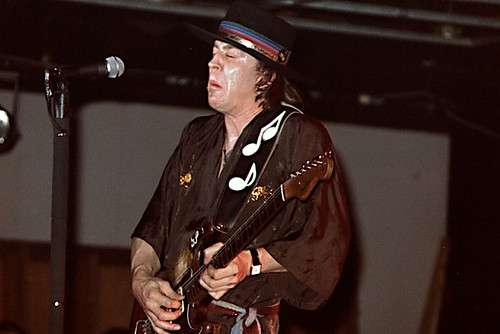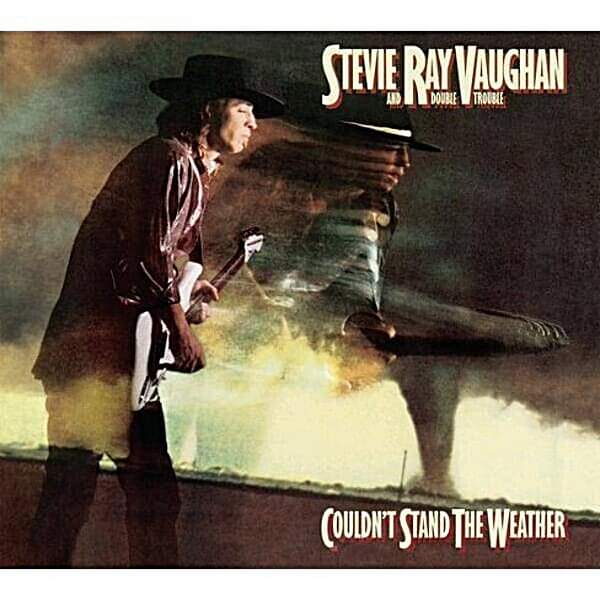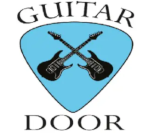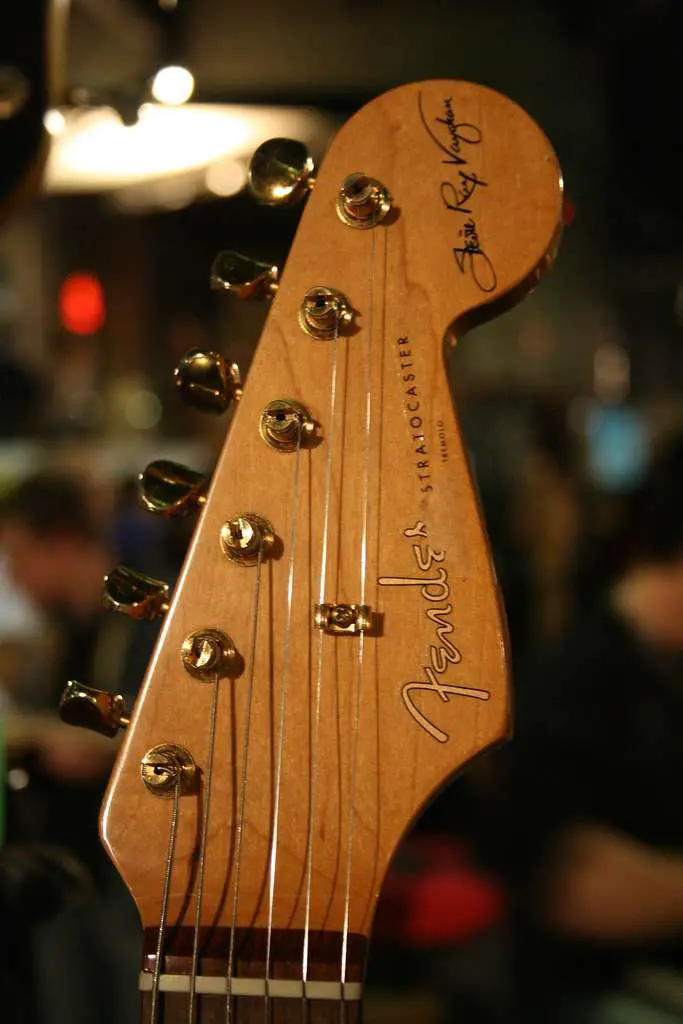Stevie Ray Vaughan, a name synonymous with blues rock, was more than just a guitar legend—he was a true style icon. Known for his electrifying performances and unique playing style, Vaughan captivated audiences worldwide. His signature look, often completed with a wide-brimmed SRV hat adorned with a feather, became an indelible part of his image. But it wasn’t just his style that made him legendary; it was his love affair with Fender Stratocasters, particularly his beloved “Number One,” that cemented his place in music history. Though often surrounded by myths, Vaughan’s legacy continues to inspire and influence generations of musicians.
Stevie Ray Sweating Bullets and Big Bird Tattoo’s

Stevie Ray Vaughan: The Guitarist Who Changed My Life
Stevie Ray Vaughan didn’t just influence my life—he changed its course entirely. Many guitarists share similar stories, but here’s mine, a tale of passion sparked by a single moment.
I was 13, already deep into the world of guitar, thanks to bands like The Rolling Stones, Rush, and Frank Zappa. I hadn’t yet decided on a clear path for my future, but in 1985, that all changed, and fast.
At the time, I had signed up for BMG Music. For those who might not remember, BMG was a mail-order service where you could choose a handful of albums, either on vinyl or cassette, for just the cost of shipping. After that, you were committed to buying a certain number of albums later on.
A few weeks before I received my first batch, I was flipping through a guitar magazine when a photo caught my eye. There was this guy, shirtless, with a bird tattoo, dripping with sweat, and wearing a hat that looked like something out of a Zorro movie. Beneath the image was a name: Stevie Ray Vaughan. Intrigued, I checked the BMG catalog and found they had his album from the previous year, 1984’s Couldn’t Stand the Weather. I ordered it, and to this day, I still consider it the best SRV album ever made.

Getting Stevie’s First Albums in the ’80s
When the album finally arrived in the mail, I rushed to put it on the turntable. From the very first track, “Scuttlebuttin’,” I had to pause. What I heard was so extraordinary that it actually scared me. I needed a moment to process it—this was something otherworldly. I had no idea a guitar could sound like that, let alone that a human being could play with such speed and still be so soulful. It was like witnessing a UFO—one of those “whoa, hold up, I need a minute” moments.
A Ride Through the Storm: Discovering Stevie Ray Vaughan
I placed the needle back on the record and let the music take me on a journey. As I listened, I studied the album artwork—a striking double exposure of a man standing in front of a tornado. By the time the last track on side one, “Voodoo Chile (Slight Return),” finished, I was in awe. It was a cover of Hendrix, and dare I say, it might have been even better. It was as if I had been transported to another world—”We aren’t in Kansas anymore, Toto.” The experience was both thrilling and unsettling, so much so that I had to replay the track just to make sure I’d heard what I thought I did.
In my opinion, it’s one of the most intense performances ever captured on record. Side two only reinforced that feeling—Stevie Ray Vaughan was a force of nature, a tornado of emotion. He could deliver anything from the bone-chilling rock of “Tin Pan Alley” to the smoky, late-night blues of “Stang’s Swang” with the same genius, even dabbling in jazz with finesse. Like the Hank Ballard song on his next album would say, “And that ain’t all!”
The following week, while flipping through the Columbus Dispatch, I spotted an ad: “Stevie Ray Vaughan & Double Trouble, Veterans Memorial Auditorium, September 29, 1985, $12.50.” This was going to be my second concert ever, and much like Cameron Crowe’s story in Almost Famous, my mom drove me to the show and waited in the car for three hours. She later confessed that after seeing Stevie on television, she regretted not getting a ticket herself.
Veterans Memorial Auditorium usually had a pretty laid-back atmosphere, but not that night. SRV was now touring for his third album, Soul to Soul, and as a bonus, we got to see blues legend Johnny Copeland open the show. He stalked the stage like a gunfighter in a blue leisure suit, nearly stealing the spotlight. The Dispatch review the next day said he almost did, but I’m not so sure the writer stayed for the whole show. My friends and I were way in the back, maybe even the last row, but in that small venue, it didn’t matter—we were part of something
Unforgettable.SRV with Double Trouble Starwood TN 1987
We were all new to Stevie so we didn’t know that this was “I’m putting cocaine in my whiskey” Stevie but his habits had not really come to be adverse to him yet. I have never in my lifetime felt energy flow through a room the way that night was, with the Exception of my Next concert a band Called Metallica with Cliff Burton.

The set opened with “ScuttleButtin” and some radio interference coming through the amps, be it Military or Police traffic. It didn’t break his concentration and was resolved quickly The Material was mostly centered that night from “Weather “ and the new Album “Soul to Soul” which I purchased a few days after this show. The Band had added in Keyboardist Reese Wynans so there were some longer jams back and forth but never a question on who the Boss was. “Look at Little Sister” The aforementioned Hank Ballard song was a highlight.” Looking out the window” Took things back to a Buddy Holly vibe and the same as you can find on the “Live at Montreux” DVD Johnny Copeland was a guest on a blistering variant of “ Tin Pan Alley”. Copeland ad-libbing verses and the entire band being open to whatever direction the tune went.
SRV Playing “Life Without You Live” in Nashville Amphitheatre
A Journey Through Stevie Ray Vaughan’s Legacy: From Electrifying Concerts to Personal Encounters
A Night to Remember: The Power of “Life Without You”
The stripped-down, soulful performance of “Life Without You” was nothing short of incredible. Every song that night was a relentless masterpiece, but the finale was something else entirely. Stevie Ray Vaughan closed the show with a mind-blowing combination of “Voodoo Child” and “Third Stone from the Sun,” paying homage to Hendrix in a way that arguably rivaled the original. During “Third Stone,” I thought his guitar strap had accidentally come off—but I was wrong.
What happened next was pure sonic anarchy. Vaughan threw down his beloved “First Wife” Stratocaster and unleashed a display of psychedelic mayhem, stomping on the guitar, riding it, and slamming it with the whammy bar to create sounds that seemed almost supernatural. When he finally said, “Thank you, good night,” the crowd was left in shock, jaws dropped, and adrenaline pumping.
But that wasn’t the end of the excitement. What my cousin and I later referred to as “the one-man riot” kicked off. While most of the crowd was buzzing with excitement, one guy couldn’t contain himself. He started jumping over chairs like a frog on a trampoline, heading for the lobby. As I was buying my tour shirt, this guy—who was so short he barely had a foot on the large brass ashtray he grabbed—hurled it through a plate-glass window and took off running. Security didn’t stand a chance.
The Aftermath: A Lesson in Showmanship
This little riot wasn’t just a crazy story—it had consequences. The next time we saw Stevie at Veterans Memorial, he seemed aware of what had happened. After another intense show, he stayed on stage and played a calming piece that would later become “Riviera Paradise,” as if to cool everyone down before they left.
I remember going to school the next morning, proudly wearing my new tour shirt and grinning like I had a secret. That shirt, by the way, eventually found a home in the SRV Museum in Dallas. It was the last piece needed to complete the museum’s collection, and I happily handed it over after a conversation with Craig Hopkins, who mentioned it was one of only two shirts no one else was willing to part with.
From Concerts to an Unexpected Opportunity
From that first gig, I became a devoted follower, attending every show I could. After a parental ban on rock concerts following the Metallica/Ozzy tour in ‘86, I found a loophole: I convinced my dad to see Stevie Ray Vaughan and Gregg Allman with me. He agreed, and even wore a Harley Davidson T-shirt so he wouldn’t look like a lawyer. We caught the June 23rd, 1987 show at Riverbend, where my dad declared Stevie Ray Vaughan the hardest-working musician he’d ever seen, though he was puzzled by the ostrich feather in his hat and the white high-top tennis shoes with a blue suit.
Just weeks later, on August 13th, I was at yet another show, this time at the Ohio State Fair. I witnessed Stevie gluing his fingertips back on with Super Glue mid-performance, and my mom surprised me by meeting me after the show with a tour shirt she’d bought—because that’s just the kind of mom she was.
One night at Veterans Memorial, we even managed to get up to the front row, thanks to a no-show on the original ticket holders. We were so close that Stevie came over and played directly to us. My cousin quipped, “Stevie’s looking spry, sporting a shave!”
My final show was on July 14th, 1990, in my original hometown of Grove City, with Joe Cocker. I vividly remember Mark Chatfield from The GODZ walking past us to the front of the stage, doing the “we’re not worthy” bow before returning to his seat. That was my twelfth SRV show. Sadly, it would be my last.
The Tragic End and a Bittersweet Memorial
Just weeks after that show, Stevie Ray Vaughan was gone, taken in a tragic helicopter crash at Alpine Valley, Wisconsin, on August 27, 1990. He was on his way back to the hotel after a two-night run with Clapton, Robert Cray, Jimmie Vaughan, and Buddy Guy. The fog was thick, visibility was poor, and they shouldn’t have attempted the flight—but they did. The helicopter crashed into the side of a man-made ski hill moments after takeoff.
There are stories about that last night, and recordings have surfaced that document his supernatural playing. He always performed like every night was his last, and tragically, that night it was. He was sober, happy, and had become a beacon of hope for those struggling with addiction. Every performance of “Life Without You” was a call to action to take care of ourselves and those we love. In many ways, Stevie Ray Vaughan was an evangelist of love—a legacy far more meaningful than any rock star status.
Over five years, I learned to play like him, to feel the music as he did. That first concert made my decision—I wasn’t just going to be a player; I was going to be a musician. That education served me well because just a night or two after SRV’s death, I ended up playing a memorial show for him at The Newport Music Hall with Columbus, Ohio’s own legend, Frank Harrison. It was a fluke—I showed up with my guitar after a radio announcement and found myself on stage, filling in. Frank wasn’t thrilled at first, but after I cut loose on “The Sky is Crying” with my Flying V, he smiled and kept me up for a few more songs. We’ve been friends ever since.
Moving On and a Full-Circle Moment
Music, especially Stevie’s music, has a way of bringing people together. But after years of trying to emulate SRV, I found myself in a rut. As Buddy Guy once said, “Ain’t no more Stevie Ray Vaughan.” I had to break out of the imitation game, and that’s where Link Wray came into my journey. Still, I owe my biggest debt of inspiration to SRV.
I lived and breathed his music, so much so that I eventually had to step away from it. Now, I revisit it like fine wine—occasionally, so it remains a touchstone.
A few years back, I got the shock of my life. I was asked if I’d like to make some cash by opening for the Kentucky Headhunters at a fairground festival. Naturally, I said yes. But it got even cooler when I arrived and met Steve Wilson, who had worked with Stevie Ray Vaughan in his later years. It was a full-circle moment, a reminder of how far I’d come since that first needle drop on “Scuttlebuttin’.”

A Hilarious Encounter with Stevie Ray Vaughan
We had plenty to chat about, but one story stood out: the infamous scooter incident. I told Steve about a friend of mine who once snuck into a gig early. As he jumped over a wall, he was promptly run over by Stevie Ray Vaughan on his scooter! Stevie, ever the gentleman, stopped and helped him up, genuinely concerned, asking, “Man, you okay?” My friend, starstruck and unfazed by the collision, replied, “I don’t care if I’m okay or not—you’re Stevie Ray Vaughan!”
Steve burst into laughter, and after we both nearly cried from laughing so hard, he shared his own worries about the scooter. “I had to ask him if that thing was gonna put us all out of a job,” he said. “I mean, if he broke an arm, we’d be done for months!”
Steve also revealed one of Stevie’s only vices in his later years—his sweet tooth. “The man was a chocoholic!” Steve said. “He’d always have Kit Kat bars or something on hand. And he loved to shake your hand when he had chocolate on his, just so you’d end up with it on you too. Then he’d laugh at you!”
You can’t buy or dream up moments like these—they just happen when you’re in the right place at the right time.
Voodoo Chile Stevie Ray Vaughan
Stevie Ray was one man who encapsulated so many qualities, beyond his music.
Like most people, I never met him, but he felt like a family member and the loss was that deep. He gave this world such Joy and gifts by his life. I often will revisit the songs, my faves are anything depending on the time but “Tin Pan Alley” “Change it” “Things that I used to Do” and “Aint gonna give up on love” all take me right back to those feelings.
Stevie Ray Film Documentary the formative years
Before we finish we have included this music video documentary on his formative years SRV’s rise as a Texas Bluesman.
If you are Looking for something really cool that often gets overlooked. Pick up the “Live at Carnegie Hall” It’s just extra special. He shook the world, now he shakes the Heavens probably playing a golden Stratocaster.
R.I.P SRV Oct 3. 1954- August 27, 1990
ji


Brilliant read love it,love Stevie Ray Vaughan
What a great story. He is my idol. I’m an old (74) hippie but for some reason only discovered SRV a few years ago. He is by far the best (and cutest) of all time. R I P Stevie – I love you. Pam